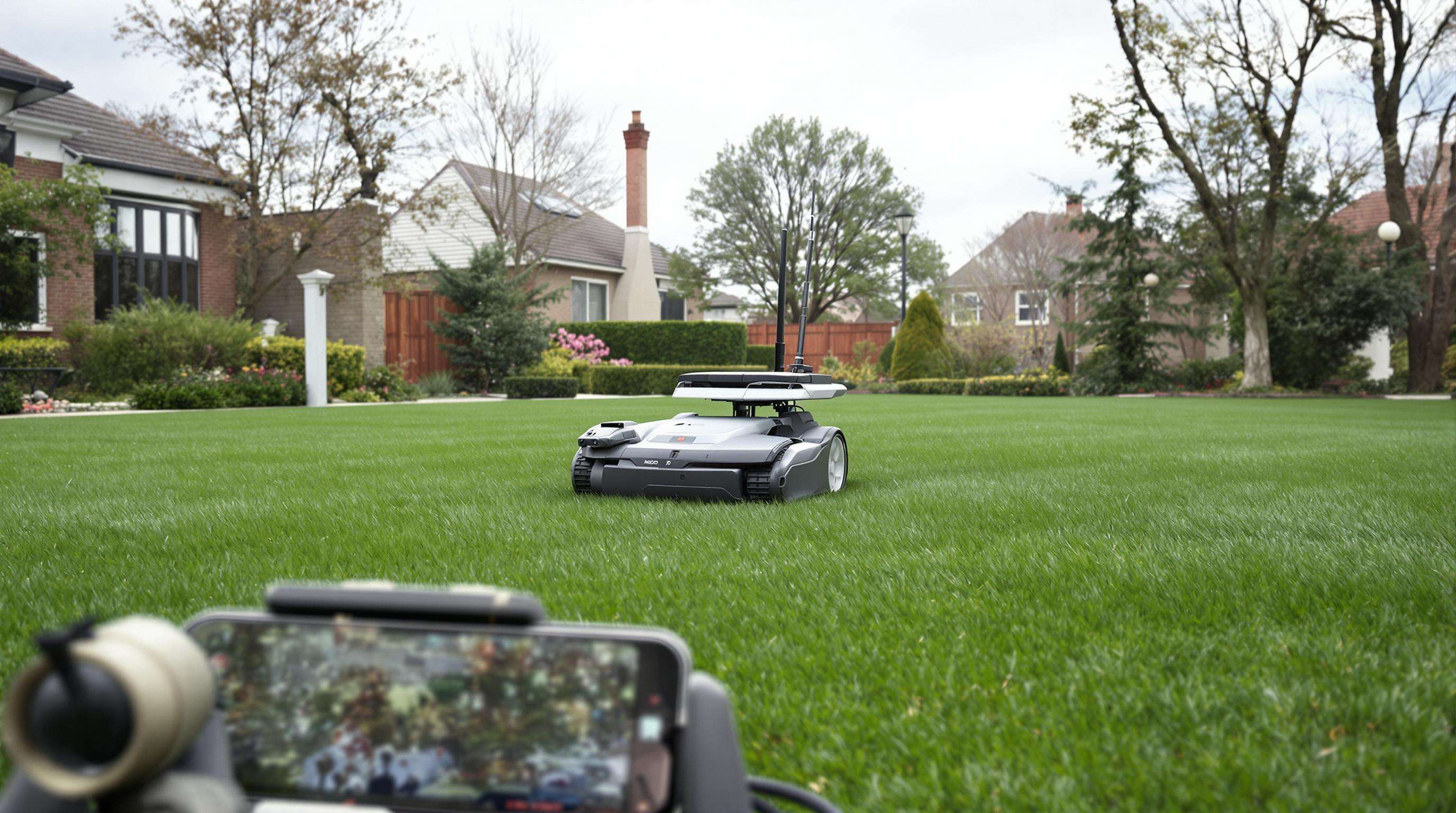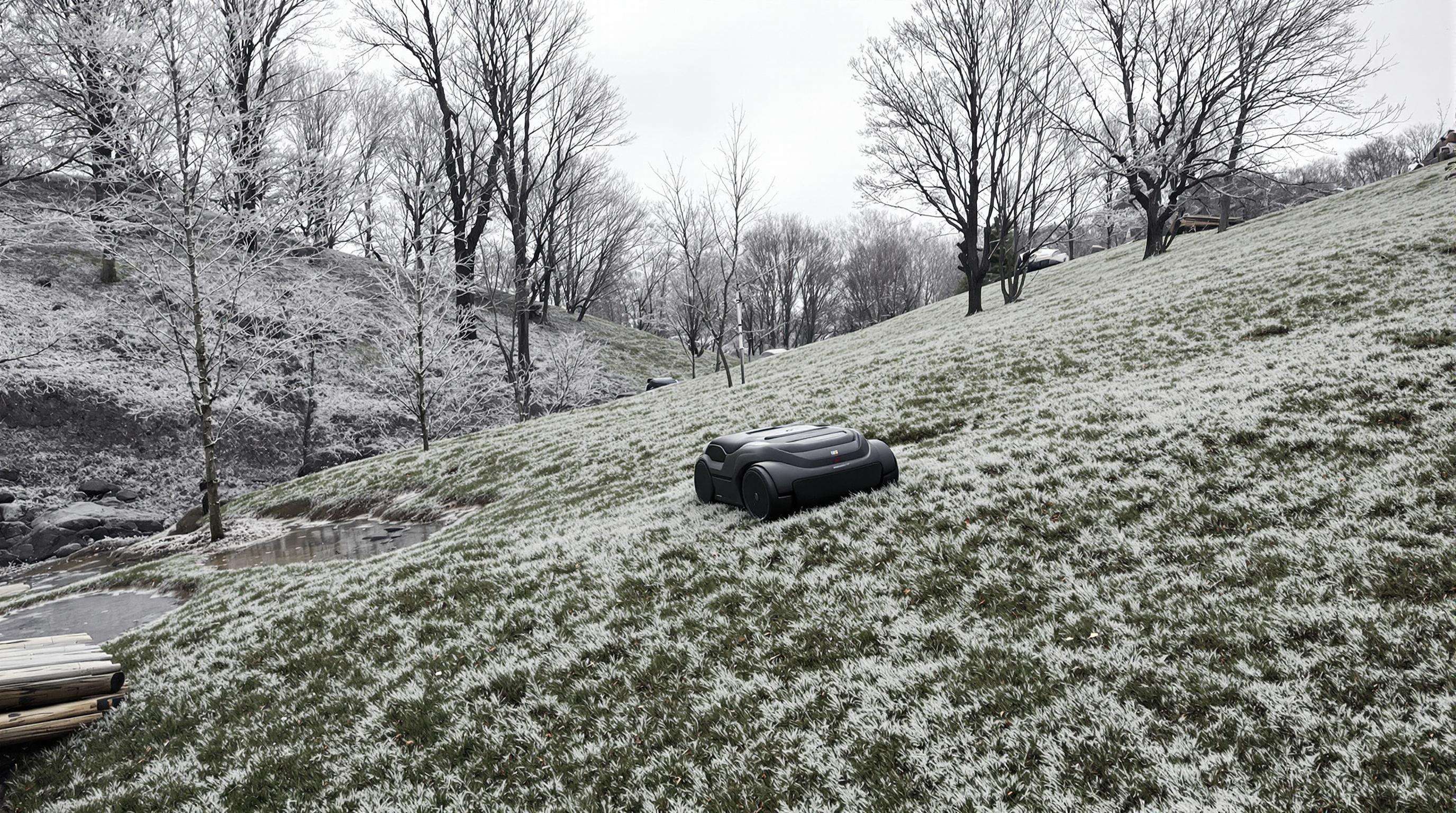יסודות טכנולוגיים של Газוניות מותקנות במנוע דלק

מערכות ניווט אוטונומיות: שילוב של GPS ו- AI
הגזוניות הרובוטיות המנוהלות מרחוק משמשות כיום מיפוי דרך GPS ותוכנת AI לייצור דפוסי גזירה מותאמים אישית. מיקוד לווייני מדויק ויציב מבטיח פעילות ללא התערבות אדם בשטח של עד 2 דונם, ולמידת מכונה מאפשרת זיהוי מתקדם של מכשולים שונים, כגון סלעים, עצים או משטחים סופיים. המערכות משתמשות בנתוני פני הקרקע בזמן אמת כדי להתאים את מהירות התערת המקסימום ואת נתיבי היעילות הגבוהה ביותר, ובכך מקצרות את מספר העברות הגזירה הכפולות ב-30% לעומת פעולה ידנית.
תפעול באמצעות אפליקציית סמארטפון וקישוריות ל-IoT
אפליקציות לסמארטפונים מותקנות גם במכונות גילוח אלו, כך שמשתמשים יכולים לתזמן את זמן הגינון שלהם, לעקוב אחרי רמת הסוללה ואפילו לקבל התראות בנוגע לצורכי תחזוקה. דגמי IoT מסונכרנים עם API מזג אויר כדי להפסיק את הפעולה בגשם ולחדש אותה בתנאי יבוש אידיאליים. מעקב GPS בזמן אמת וג'יואו-ג'יילינג (Geofencing) מבטיחים שכלבים ישארו בגבולות הנכס, והעברת הנתונים מאובטחת ברשתות Wi-Fi וסלולריות.
חוט גבול לעומת טכנולוגיות דיוק RTK-GNSS
טכנולוגיית חוטים למגיני דשא: טכנולוגיית מערכת החוטים משתמשת בגבולות הנסתרים של החצר כדי לשמור על המגינים בתוך הגבולות ולשמור על רכוש השכן מחוץ להם - פתרון מושך בהשוואה לגדרות כלבים חשמליות יקרות וגלויות לעין, והיא גם 100% בטוחה. טכנולוגיה חדשנית RTK-GNSS או מערכת לוויינית ניווט קינמטית בזמן אמת (Real-Time Kinematic Global Navigation Satellite System), זוהה אותות תקן GPS מה역יות בסיס מקומיות פעילות כדי לאפשר דיוק במיקום של ±2 ס"מ - ללא צורך בסימנים פיזיים או חיבורים לגבולות המוגדרים. הכי מתאים למרחבים בעלי צורות אי-סדירות. למרות ש-RTK-GNSS מפחיתה הוצאות על תחזוקה ארוכת טווח, היא פחות יעילה בנוכחות צמרת עץ עבה או רוויה של אותות לוויין
מגני דשא בפיקוד מרחוק אל מול אלטרנטיבות מסורתיות
יעילות בכוח עבודה ופחת בזיווי הפיזיים
ההעברה מהדרכים המסורתיות למערכות טיפוס מרחוק של הדשא הביאה להגברת יעילות כוח העבודה. מחקרים בתעשייה מצביעים על כך שמערכות אלו יכולות להפחית את צורכי העבודה הפעילים ב-60–75% בהשוואה לгазוזיות pushed ולבטל משימות חוזרות כמו הסבה ידנית ואיסוף בערמות. "במקרה של רוב הגזוזיות, אתה לא נאלץ לעמוד במרחק 100 רגל מהעשן שנפלט מגזוזיות רגילות, ולכן אתה מרגיש בנוח יושב בכיסא בגינה ולוקח קפה בזמן שהמכונה מסתובבת בחצר," כותב דונован. "ניהוג הגזוזית אינו תהליך מעיק כמו דחיפת הגזוזיות על פני עליות או אדמה בלתי שווה. הדבר חשוב גם לאנשים עם מוגבלות תנועה, כפי שעולה מהתוצאות של סקר טכנולוגיית הנוף 2024, שמראה כי 82% מבני הזקן הרגישו הפחתה במאמץ בפרקים עקב שימוש בגרזנים בשלט רחוק.
השוואת דיוק גיזום: בינה מלאכותית מול שיטות ידניות
מכשורים הנשלטים על ידי בינה מלאכותית משתמשים במיקום מדויק ברמת המילימטר, אשר נעשה בעזרת RTK-GNSS, ומסוגלים להשיג גובה אחיד של הדשא (עם סטייה של ±2 ממ) שקשה להשוות אותו בשיטות ידניות. מערכות ראייה ממוחשבות מסוגלות לזהות הבדלי צפיפות בגזע הדשא ולשלוט בתדירות הסיבוב של התורניקה ובתבניות הגיזום בהתאם – דבר שלא ניתן לייצר על ידי אופרטורים אנושיים, שנוטים לאבד באיכות הגיזום עקב עייפות או אובדן ריכוז. מבחנים מצביעים על כך שמערכות רובוטיות מורידות את עלויות השדרה חוזרת ב-19% מדי שנה, בזכות הסרת תופעות כמו גילחון יתר או אזורים שלא נגזמו בכלל שהיו קיימים בשיטות גיזום מסורתיות. זהו רמת דיוק כזו שמאפשרת לבינה מלאכותית לקבוע, לדוגמה בעת גיזום הקצוות, את אזור החפיפה האופטימלי שמפחית לכדי בלתי אפשרי כל סיכון של חפיפה כפולה.
שילוב בבית חכם של מכשורים מנוהלים מרחוק
מערכות בקרת מבוססות אינטרנט של הדברים
התקנים האלה מקושרים בקלות לרשת ה-Wi-Fi הביתית, ומאפשרים שילוב קל bidirectional של דאטה דרך שירותי ענן. במרכז נמצא אפליקציה לסמארטפון - המעקב אחר חיי הסוללה, התאמת השעונים, וקבלת משוב מיידי על הביצועים. בעלי המגרשים יכולים לסנכרן את תזמון הקציצה עם אפליקציות מזג האוויר כדי להפסיק את פעילות הקציצה בממטר, מה שמוביל לעלייה של 20–30% ביעילות המשאבים, כפי שנכתב במחקרים על גינות חכמות.
פקודות קול ושילוב באוטומציה
פועלת עם עוזרים קוליים (Google Assistant/Alexa) כך שניתן להתחיל או להפסיק את הקציצה פשוט על ידי שאומרים להם מה לעשות. *לדוגמה" לקצור את החצר האחורית." משתמשים מתכננים את מחזור הקציצה עם התנהגויות אחרות של בית חכם, כמו הדלקת אור כשהמכונה חוזרת לדוק. תוכניות אוטומטיות, לעומת זאת, יכולות לצמצם את ההזנות הידניות במחצית, ומתאימות את עצמן למחזור צמיחה של דשא בקיץ באמצעות לולאות משוב מהחיישנים.
פרוטוקולי אבטחה למערכות קציצה מחוברות
יצרנים ממומשים הצפנה בשדרת בנק (AES-256) עבור כל תקשורת בין אפליקציה להתקן, ומונעים גישה בלתי مصرחית. עדכוני קושחה קבועים פותרים חולשות כמו הטעיית GPS או השתלטויות על שליטה. אימות דו-שלבי וסגמנטציה של הרשת מגינים על נתוני המשתמש בסביבות הבית החכם המשולבות, בהתאם לסטנדרטים האזוריים UL 3030 לאבטחת סייבר במערכות רובוטיות חיצוניות.
השפעה כלכלית של גזוזי דשא מרחוק
ניתוח עלות-ประโยה להקמה בישובים
עלות ראשונית של שלט רחוק נעה בין 1,500 ל-4,000 דולר, בהתחשב בתכונות ובגודל הנכס. השקעה ראשונית זו מחזירה את עצמה תוך 3-5 שנים באמצעות חיסכון בדלק (שווה ערך לחיסכון שנתי של 210 דולר בבנזין) ועלויות תחזוקה מופחתות. בניגוד להחלפות שמן והחלפת מצתים במכסחות דשא, מכסחות חשמליות דורשות רק חידוד להבים וטיפול בסוללה. אין עוד תזמון ידני של שעות עבודה שבוע אחר שבוע. אין עוד בזבוז זמן, הזמן שלך הוא כעת שלך. למרות שהעלות הראשונית גבוהה יותר, הנוחות והחיסכון לטווח ארוך הופכים אותן לאפשרויות משתלמות עבור הכסף.
שיפור יעילות בעסקים בתחום הנויי הסביבה
גיזומת רובוטית הופכת את הכלכלה של שירותי הנוי. יעילות בכוח העבודה היא שינוינית — טכנאי אחד יכול לפקח על 4-6 יחידות בו-זמנית, באמצעות בקרת אפליקציה מרכזית, ובכך לקצץ בדרישות כוח אדם במחצית, בהתאם לממוצע בתעשייה. גיזום כל היום ניתן לבצע מבלי לדאוג להגבלות על תשלומים בגין שעות נוספות בעבודה מאוחרת עד השחר. המערכות יתרמו להרבה רווח שכן עלויות שכר חוזרות נעלמות והשירות מוגדל. (יעילות התפעוליות הללו פועלות ישירות נגד אחת הבעיות הבולטות ביותר של מחסור בכוח עבודה בתעשייה, כפי שמאותרת בניתוח שוק גלובלי מ-2025.) ההרחבה מתבצעת דרך ניהול צי רכבים, ולא באמצעות שכירת כוח עבודה ליניארית.
נתיבי אבולוציה עתידיים למכשורים חשמליים עם בקרת מרחוק
יישורדים מתקדמים ופלטפורמות רב-תכליתיות
דור חדש של גזעי דשא בקרת-רחוק ייחודית (גרסה 3.0) דומים לרובוטים; הם מסוגלים לגזור מרעה כולה בזמן שהמפעיל נדרש לעשות כלום מעבר לעקיבה. תחזיות התעשייה מצביעות על כך ש-30% מהדגמים החדשים יכללו אביזרים לטיפול בבזר, הדשה והשקיה עד שנת 2028. חיישנים סביבתיים מובנים מודדים את רמת הרטיבות והחומרה בממוצע בזמן אמת, ומאפשרים טיפול מדוקדק במרעה מעבר לגיזוז בלבד. עיצוב רב-תכליתי זה עוזר למבקשי בית להחליף כלים בעלי שימוש יחיד לגזיז וסימון, תוך מתן פתרון מותאם אישית לניהול חצר ובניית מערכת אקולוגית משלימה. יתרון נוסף הוא היכולת לעדכן את הפונקציונליות של החומרה העיקרית כדי להתאים את עצמכם לצרכים עונתיים בגינון, מבלי שיהיה צורך לקנות מערכות חדשות.
טכנולוגיות חוצות precision agriculture
מערכי GNSS וחיישנים לדרגת חקלאות מתקנים עם טכנולוגיית דשא בדרגת צרכן כדי לשפר את הנסיעה על פני הקרקע. מיקוד קינמטי בזמן אמת מספק מיפוי של גבולות וניתן להשתמש בו כדי להתאים את הקרקע לתכונות כמו שיפועים, ופוחת את הצורך באיזון ידני ב-50% לעומת הדור הקודם. מעליות יכולות כעת ללכוד סריקות קרקעיות מהאוויר המשולבות במערכת הניווט של מכונת הגז כדי ליצור דפוסי גזירה מותאמים למשטחים לא אחידים. אלגוריתמי רגישות לחות, שנטענו ממערכות ההשקיה החקלאיות, משמשים לייעול מחזור התפעול עבור יעילות מרבית. חדשנות בין תחומי כמו זו עשויה בקרוב לסייע בתפעול שדות סולריים ומרחבים ירוקים בסביבת המשרד הקשה.
אתגרי יישום בממתקי דשא בשלט רחוק

פאראדוקס תעשייתי: נגישות מול תכונות מתקדמות
ההתפתחות האחרונה במגרזות דשא מונעות מרחוק מחמירה את המתח הזה בין דמוקרטיזציה של גישה ואינטגרציה של תכונות מתקדמות. למרות ש-58% מהבעלים דואגים להון שמחיר נמוך הוא החשוב ביותר בטכנולוגיה לדשא, יצרנים נתקלים בבעיות של עלויות מחקר ופיתוח של יותר מ-1.2 מיליון דולר לגרסה של מערכת ניווט אוטונומית. עסקים נמצאים תחת לחץ הולך וגדל, ורבים מהם נאלצים לבחור בין ויתור על תכונות בדגמים זולים או לחייב 300% יותר עבור דגמים מתקדמים – דבר שכנראה יגרום ל-72% מהקונים מהשכבה הבינונית פשוט 'לברוח מההר'.
ממשקים פשוטים של אפליקציות וירידות בקוד התוכמה המבוסס על אינטרנט של הדברים (IoT) מנסים לכסות את הפער הזה, אך לפי סקרים עדכניים, 41% מהמשתמשים עדיין מציינים עקומה תלולה של למידה. האבסורד מתגבר כאשר הצרכנים דורשים גם יכולת מתקדמת להימנע מקנסות ברמה צבאית וגם מחיר מתחת ל-500 דולר – דרישה שת технологיות הסוללות והחיישנים הנוכחיות אינן מסוגלות לאזן ביניהן.
הגבלות טרמיות ואילוצים של מערכת הניווט
גם דגמים פרימיום עם מיקום RTK-GNSS מתקשים בעלות על מדרונות круיים מ-35% או אזורים יערוניים צפופים שבהם אחוז האובדן של אותות לוויין מגיע ל-22%. מבחנים אחרונים של יצרנים מובילים חושפים:
| סוג טרם | שיעור הצלחת ניווט | עלייה בצריכת סוללה |
|---|---|---|
| דשא שטוח | 99% | קו בסיס |
| גבעות מתנופפות | 84% | 37% |
| אדמה סלענית | 61% | 112% |
התבססות על חוט תחום מהווה מכשול להתקנה אצל מותגים זולים, ו-29% מהצרכנים מבצעים התאמה שגויה של מערכות הגבול בזמן ההתקנה. טכנולוגיה חדשה ליצירת מפת טרראין באמצעות LiDAR מציעה פוטנציאל, אך עם עלות נוספת של 700$ ומעלה, היא אינה ניתנת להשגה עבור 50+ נכסים שבבעלות גננות מסחריות. רגישות למטאורולוגיה טרם נפתרה: גשם גרם לאובדן של 18% בדיוק של חיישנים, וקיפוח - בממוצע - הגדיל את זמן המחזור הדרוש למיפוי בתנאי חורף ב-43%.
שאלות נפוצות
איך גזעי דשא בשלט רחוק מנווטים בסביבה?
גזעי דשא בשלט רחוק משתמשים במפות GPS ותוכנת בינה מלאכותית לנווט אוטונומי. הם יכולים לזהות מכשולים ולסגל את דפוסי החיטה בהתאם, תוך שימוש בנתוני פני השטח בזמן אמת.
מהן ההטבות המרכזיות של שימוש בגזע דשא בשלט רחוק לעומת גזעים קונבנציונליים?
Газוניות מותקנות מרחוק מגבילות את המאמץ הידני ומשפרות את הדייקנות בגזירה, הן מורידות את צורכי העבודה הפעילים ב-60-75% ומציעות נוחות וחיסכון לטווח רחוק
האם גזוניות מותקנות מרחוק תואמות למערכות בית חכם?
כן, הן יכולות להשתלב במערכות אינטרנט של הדברים (IoT), להציע שליטה דרך יישום סמרטפון ולעבוד עם עוזרים קוליים לצורך אוטומציה בתחזוקת הדשא
מהן האתגרים העומדים בפני גזוניות מותקנות מרחוק?
בינהל שטחים מורכבים, התמודדות עם ניתוק אות באזורים עבותים, מורכבות בהתקנה הראשונית, והתייחסות לנגישות לעומת הגבלות בתכונות מתקדמות

